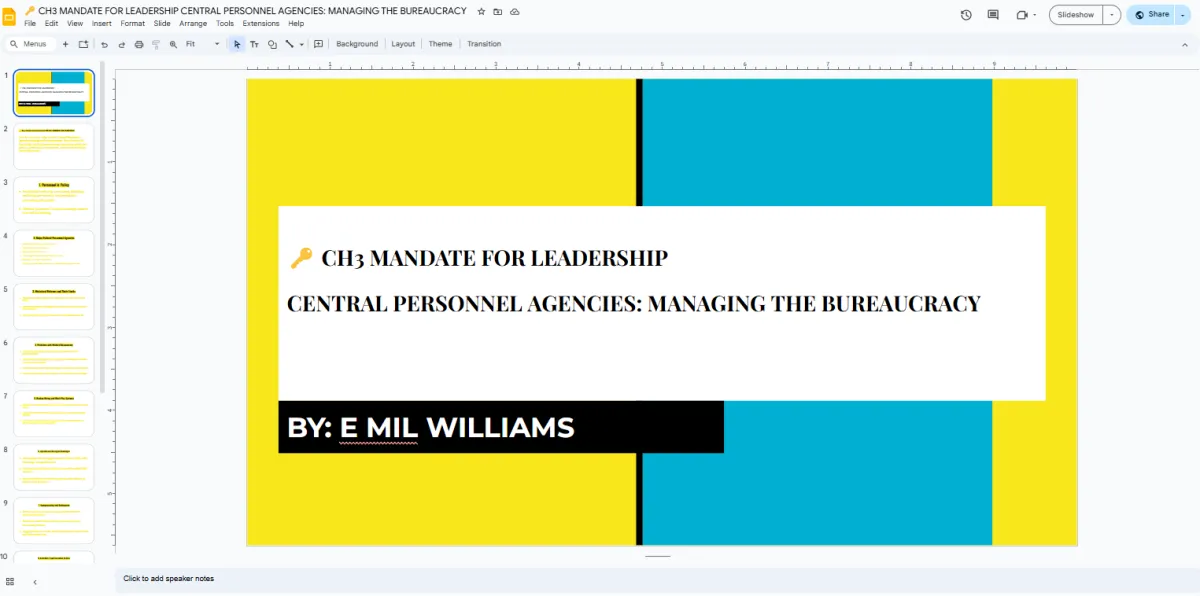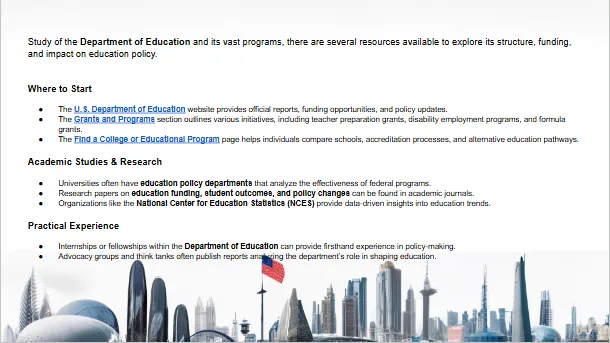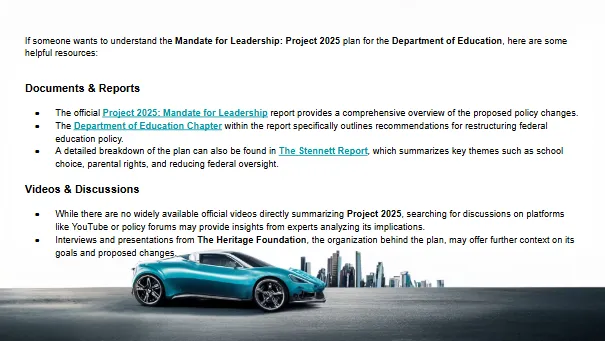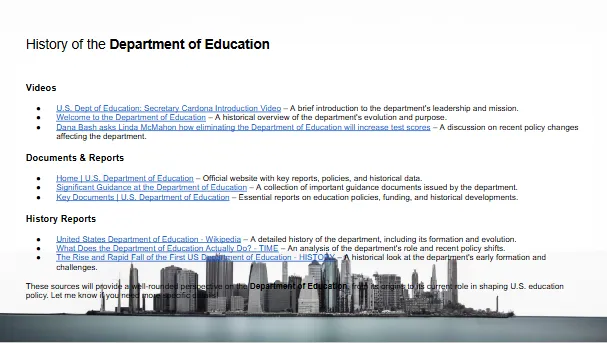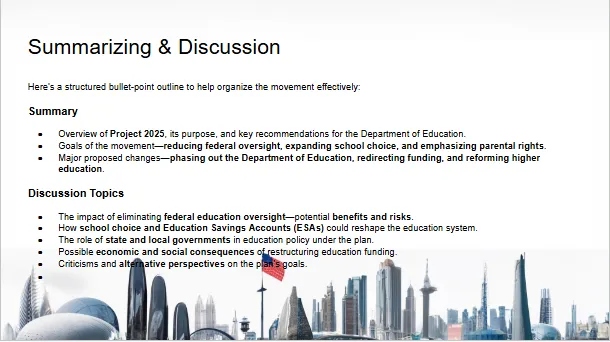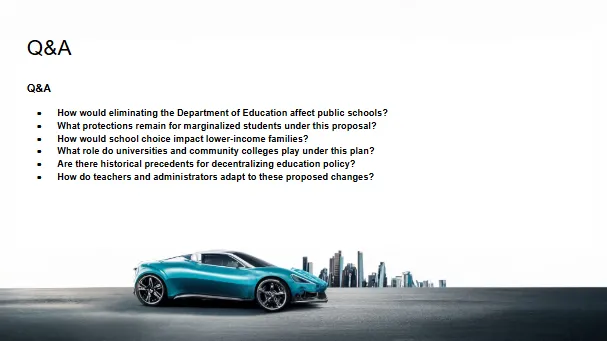UNDERSTANDING THE CONSERVATIVE PROMISE: MANDATE FOR LEADERSHIP
Project 2025 Watch
EXECUTIVE BRANCH
VS
CONSTITUTION
Chapter 3:
CENTRAL PERSONNEL AGENCIES: MANAGING THE BUREAUCRACY
Review
Reading Mandate with Summary
Here’s a summary of the section titled "Central Personnel Agencies: Managing the Bureaucracy" by Donald Devine, Dennis Dean Kirk, and Paul Dans from Mandate for Leadership:
Key Themes:
1. Personnel is Policy
The authors emphasize that the President's authority to appoint, direct, and remove personnel is central to executing his policy agenda.
Effective governance requires prioritizing personnel management, as appointees shape the direction and success of administration goals.
2. Major Federal Personnel Agencies
These agencies manage and oversee federal employment and labor practices:
Office of Personnel Management (OPM):Leads civil service policy including retirement, pay, training, and hiring.
Advises the President and enforces merit system principles.
Merit Systems Protection Board (MSPB):Acts as a neutral adjudicator for employee disputes such as firings or demotions.
Federal Labor Relations Authority (FLRA):Manages labor disputes and union matters in the federal workforce. Office of Special Counsel (OSC):Investigates whistleblower complaints and violations like political coercion.
Equal Employment Opportunity Commission (EEOC):Handles federal employee discrimination complaints.
General Services Administration (GSA):Oversees government contracting, indirectly affecting personnel since contractors outnumber civil servants.
3. Historical and Structural Reform
Pendleton Act (1883): Created a merit-based civil service to replace the partisan spoils system. New Deal Era: Expanded and institutionalized civil service protections.
Civil Service Reform Act of 1978 (CSRA):Initiated under President Carter and implemented by Reagan.
Introduced performance-based evaluations, bonus incentives, and efforts to increase accountability.
Ultimately, reforms lost traction within a decade.
4. Problems with the Modern Bureaucracy
Civil service protections have made it nearly impossible to fire underperforming employees.
Complex hiring/firing rules stifle managerial flexibility.
Ratings inflation and pay uniformity reduce motivation and efficiency.
Progressive ideals of an expert, neutral bureaucracy have led to a lack of accountability and public frustration.
Conclusion:
The authors argue that the federal personnel system, originally meant to enhance professionalism and impartiality, has become bloated and unaccountable.
They call for a renewed focus on reforming personnel management to ensure government efficiency and alignment with the President’s policy goals.
Chapter 3:
CENTRAL PERSONNEL AGENCIES: MANAGING THE BUREAUCRACY
Review
PAGE 69-86
AUTHOR: Donald Devine, Dennis Dean Kirk, and Paul Dans
AUTHOR BACKGROUND CHECK:
Dennis Dean Kirk is a veteran legal expert in federal personnel management, known for his strong advocacy of civil service reform and a long-standing association with conservative legal and political movements. He served as Chair of the U.S. Merit Systems Protection Board under President Trump, where he focused on reducing bureaucratic resistance to presidential authority and streamlining the federal disciplinary process. In Project 2025: Mandate for Leadership, Kirk contributes to the section focused on reshaping the federal workforce to align more closely with executive priorities. He supports the reinstatement and expansion of "Schedule F," a controversial policy designed to make it easier to hire and fire federal employees in policy-influencing roles, effectively weakening the traditional protections of the civil service. Kirk's proposals reflect a broader effort within the Heritage blueprint to centralize control within the executive branch, reduce the influence of what is often described as the “deep state,” and ensure federal personnel are ideologically aligned with administration goals. His involvement underscores the project's emphasis on remaking the federal bureaucracy to reflect conservative governance principles.
Dennis Dean Kirk:
Kirk served as the Associate Director of Personnel Policy for Project 2025. He co-authored Chapter 3 of the project's "Mandate for Leadership," focusing on central personnel agencies and strategies for managing the federal bureaucracy. Kirk was nominated by President Donald Trump in 2018 to chair the Merit Systems Protection Board, an agency that provides federal employees a venue to appeal unfair dismissals. However, his nomination was not confirmed by the Senate, and he did not serve in the role.
Newsweek
Paul Dans:
Dans was the Director of Project 2025 until August 2024.
He previously served as Chief of Staff at the U.S. Office of Personnel Management during the Trump administration, where he was involved in efforts to align federal staffing with conservative agendas.
Dans played a pivotal role in developing Project 2025's comprehensive plan to overhaul the federal government, including creating a database of potential appointees aligned with conservative values.
He stepped down from his role amid controversy and criticism, including from former President Trump, who distanced himself from the project.
Here’s a summary of the section from Mandate for Leadership: The Conservative Promise focused on civil service reform, performance appraisal, and merit pay:

5. Executive Order 13839 (Trump Administration)
Required faster action on poor performance, restricted settlements that altered personnel records, and aimed to discipline retaliatory supervisors.
Revoked by the Biden Administration, but could be reinstated in 2025 by a reform-focused leadership.
6. Role of Political Leadership in Appraisals
Political appointees should take responsibility for performance evaluations rather than delegating to entrenched managers.
Without political oversight, hard-working staff go unrecognized and underperformers are uncorrected.
Key Themes and Issues:
1. Performance Ratings Are Inflated and Meaningless
Nearly all federal employees are rated "fully successful" or above, weakening any meaningful link between performance and pay.
Senior Executive Service (SES) bonuses are supposed to go only to top performers, but in practice, almost everyone is rated outstanding.
This creates a system where pay raises and bonuses are nearly automatic, regardless of actual performance.
2. Collapse of Merit-Based Hiring
The federal hiring process has been undermined by the elimination of objective entry exams like the PACE test.
This occurred through a 1980s legal consent decree meant to reduce racial disparities, which still limits the use of rigorous entry testing today.
Managers now rely heavily on subjective assessments or pre-selection, limiting the quality and fairness of hiring.
3. Attempts to Reintroduce Objective Testing
The USAHire system (initiated under Obama and planned for expansion under Trump) aims to restore some level of skill-based testing.
Legal fears of “disparate impact” have slowed or halted progress in implementing such systems.
4. Performance Appraisal System Is Broken
Meaningful evaluations are rare due to:
Social discomfort in rating colleagues.
Fear of being accused of discrimination.
Bureaucratic resistance to acknowledging underperformance.
Only 0.1% of employees are rated “unacceptable.”
This lack of honest assessment hinders both discipline and reward, damaging accountability and morale.





Project 2025 Belief in Work Ethic of Government Workers
Merit Pay Reform:
Private sector: Over 90% use merit-based pay linked to performance appraisals.
Federal government: Pay is still largely seniority-based, despite early efforts in the Carter and Reagan years.
Reagan’s OPM attempted to expand pay-for-performance (PMRS system), but Congressional opposition—particularly from union-aligned lawmakers—blocked long-term implementation.
The original merit pay system expired in 1993 and hasn’t been revived.
Current political leadership should use existing legal tools to strategically reward high performers, even while pushing for broader legislative reform.
Conclusion:
The report argues that the civil service system lacks accountability, transparency, and incentives for excellence.
Rigorous hiring practices and honest performance evaluations must be restored.
A reform-oriented President and Congress could revive merit-based pay and hiring, ensuring that federal personnel align with effective governance and the President’s policy vision.
WORDS OF ENCOURAGEMENT
For those working in the federal government during this period of uncertainty and potential reform, it's important to stay grounded, focused, and adaptable. While sweeping changes may feel unsettling, your daily commitment to professionalism, integrity, and public service remains essential. Lean into what you can control: maintain high personal performance, document your work clearly, stay informed on policy updates, and seek out opportunities for growth and learning. Support your colleagues by fostering a respectful, mission-driven environment, even as the landscape shifts. Remember that resilience isn't about resisting change—it's about finding your place within it and continuing to serve the public with excellence, no matter the challenges ahead.

REFORM PROPOSALS FROM MANDATE PROJECT 2025
1. Appeals Process in Federal Employment
Extremely low dismissal rate in the federal workforce (<1%), with far more job security than the private sector.
Complex, overlapping appeal systems (MSPB, EEOC, FLRA, OSC) discourage managers from firing underperformers due to time-consuming legal hurdles.
Forum shopping is common, allowing employees to bring cases to multiple agencies with little consequence for frivolous claims.
Backlogs are substantial: MSPB had ~3,000 cases (some dating back to 2013); EEOC had 42,000 cases as of January 2023.Proposed reform: Consolidate appeals processes under MSPB, limit union powers, and reassign responsibilities (e.g., EEOC federal employee claims to MSPB, OSC investigations to OPM).
2. Federal Pay and Benefits
Official data understate the true cost of federal employment by excluding contractor spending and underreporting liabilities.
While some reports claim federal workers are underpaid, independent studies show they earn 14%–22% more in wages and 30%–61% more in total compensation than their private-sector peers.
Generous benefits include high locality pay, cost-of-living raises, more vacation and sick days, and superior health coverage.
Suggested reform: Shift toward a market-based compensation model, with OPM overseeing pay scales, based on occupation, region, turnover rates, and applicant supply.
3. Retirement Reform
Federal employees retire earlier with better benefits than private workers, often receiving fully inflation-indexed pensions.
The shift from CSRS to FERS in the Reagan era helped cut retirement costs from 44.3% to 28.5% of payroll, saving billions.
Even under FERS, federal retirement is still more generous than private-sector equivalents.
Further alignment with private-sector retirement norms is encouraged.
4. GSA’s Role
The General Services Administration (GSA) is not only a real estate manager but also plays a role in personnel and contractor management.
Regular coordination between GSA and OPM is recommended for better alignment on contractor and civil service staffing and transitions (like during presidential transitions).
5. Reductions-in-Force (RIFs)
Past efforts (Clinton, Obama, Reagan, Trump) to reduce the federal workforce through hiring freezes yielded limited and temporary effects.
Real personnel costs lie in contractor growth (20 million contractors vs. 2 million federal employees) and federal grant-funded state workers, which are harder to reduce.
Buyout programs (e.g., early retirement incentives) are costly and can be counterproductive if replacements are hired soon after.
More impactful than cutting headcount is cutting unnecessary functions, programs, and grant expenditures.
Understanding what this part of the Mandate means to you?
🔒 Freezing and Restructuring Federal Hiring
Immediate hiring freeze recommended for top career positions to prevent political appointees from “burrowing in.”Layoffs should prioritize performance over seniority, tenure, and veterans’ preference—though legislative attempts to shift this have failed due to union and managerial opposition.
Calls for stronger performance-based personnel policies and skepticism toward costly reduction-in-force (RIF) strategies.
🏢 Combatting Bureaucratic Inefficiency
The federal bureaucracy is bloated, fragmented, and layered with inefficiencies (50+ levels between top officials and service recipients).Past reforms like the Government Performance and Results Act (1993) failed to reduce government size or improve outcomes.GAO found over 90 opportunities for cost reduction and performance improvement.
Recommends cutting overlapping programs, budget reduction, and devolving responsibilities from federal to state/local levels.
👔 Career Management and Political Control
Reaffirms that career civil servants lack independent constitutional authority and should not lead policy changes.
Supports Senior Executive Service (SES) reforms to make civil service responsive to elected leaders while maintaining professionalism.
Warns against “burrowing-in” tactics and career staff reserving key roles to block political appointees.
🧾 Reinstating Schedule F and Executive Orders
Supports reinstating Trump’s Schedule F executive order, which reclassified some high-level policy roles to be exempt from typical civil service protections.
Argues it ensures accountability and flexibility in hiring for policy-influencing roles.
🤝 Union Reform and Resistance
Federal employee unions are seen as obstacles to effective governance.
Calls for:
Reinstating Trump-era executive orders (EOs 13836, 13837, and 13839) limiting union influence.
Restricting union official time, reducing grievance powers, and prioritizing performance over seniority.
Suggests reevaluating the legitimacy of public-sector unions altogether, echoing early 20th-century views.
🧑💼 Filling Political Appointee Positions
Emphasizes need for the President to swiftly and fully staff political positions to maintain control of the executive branch.
Criticizes Trump’s early failure to do so, which left agencies in the hands of career holdovers and opposition-party loyalists.
Proposes a strong, coordinated effort among the White House Personnel Office, OPM, and agency leadership.
🏛️ A Call for Bureaucratic Reform and Decentralization
Claims the current federal bureaucracy is inefficient, overpaid, and unaccountable, failing its own merit-based ideals.
Attributes these failures to progressive ideology, which expanded federal authority far beyond constitutional intent.
Calls for a return to Madisonian principles—decentralization, privatization, and a leaner federal government.
📌 Conclusion
The chapter pushes for:
Centralization of political control over the civil service.
Massive reductions in bureaucratic size and functions.
A federal workforce guided by performance, accountability, and loyalty to elected leadership, rather than entrenched careerism or union protection.

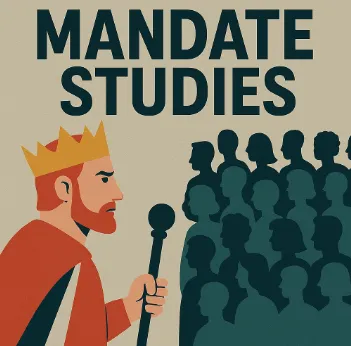
Understanding How the Mandate Effects Our Government by Sections of the Mandate
The following is a breakdown of the 900+ pages in a deeper breakdown of the authors, the standards, diagnosing the reforms, deep understanding of what our tax payer dollars provide and a deeper understanding of the deep Right. We do not have a deep Left issue, we have a issue with those who are lacking credibility with plans that are outlined in black and white. Instead of just living through the next 4 years, learn from America's Mistake for allowing nepotism to override political career morally sound individuals to decide people's fate versus those who are born of privilege. In these library of collective thoughts please feel free to join the movement...
Monitoring the Mandate by diving into the authors, contributors and current implementation of the project 2025 mandate created in 1978 first ran by Ronald Raegan with the Heritage Foundation.
Understanding the fundamentals of the Mandate by diving into the theories, philosophies and breakdowns from the section "Taking the Reins of Government" with break downs from
Understanding the fundamentals of the Mandate by diving into the theories, philosophies and breakdowns from the section "The Common Defense" with break downs from:
Understanding the fundamentals of the Mandate by diving into the theories, philosophies and breakdowns from the section "The General Welfare" with break downs from:
Understanding the fundamentals of the Mandate by diving into the theories, philosophies and breakdowns from the section "The Economy" with break downs from:
Understanding the fundamentals of the Mandate by diving into the theories, philosophies and breakdowns from the section "Independent Regulatory Agencies" with break downs from:
Understanding the fundamentals of the Mandate by diving into the theories, philosophies and breakdowns from the section "Onward" with break down and final thoughts on project 2025:
Understanding the Mandate , What it means to you and how can we grow from learning it.

Stand up for US Department of Education Against Project 2025 Mandates
The future of education is at a crossroads, and the Department of Education plays a vital role in ensuring access to quality learning opportunities for all. However, proposed policies threaten to dismantle essential programs, impacting students, teachers, and communities nationwide. By joining together, we can advocate for a strong, well-supported education system that prioritizes inclusivity, innovation, and success. Whether through raising awareness, participating in discussions, or pushing for informed policies, every effort counts in safeguarding the integrity of public education.
This is a call to action for educators, advocates, and concerned citizens to come together and make a difference. Through collective knowledge and active engagement, we can challenge harmful reforms and champion initiatives that strengthen the Department of Education. The upcoming virtual workshop on April 21-23 will provide key insights into these urgent matters, equipping participants with the tools to take action. Let’s stand for the future of education—because protecting learning today ensures a brighter tomorrow for all. Join us in this mission and help drive meaningful change!
Power Point For 3 Day Workshop 6pm-8pm April 21-23, 2025
Understanding the Mandate Which Touches the Following
The following is a breakdown of the 900+ pages in a deeper breakdown of the authors, the standards, diagnosing the reforms, deep understanding of what our tax payer dollars provide and a deeper understanding of the deep Right. We do not have a deep Left issue, we have a issue with those who are lacking credibility with plans that are outlined in black and white. Instead of just living through the next 4 years, learn from America's Mistake for allowing nepotism to override political career morally sound individuals to decide people's fate versus those who are born of privilege. In these library of collective thoughts please feel free to join the movement...
Executive overreach redefining the Constitution and it's relationship with the other branches
The Common Defense Outlining the Agency Roles
US Press
International Press
The Economy Outlines the Roles
Case for Fair Trade
Case For Free Trade
The Independent Regulatory Agencies Outlines the Roles For Agencies
The propose for this Summary is in an attempt to allow others to understand that this mission statement known as the Mandate is different than just a political movement. This movement purpose is not meant to help those who it claims to and we would argue that their Mandate has and will do damage to our world. This has been a journey of exploration, interesting, hypocritical, short sighted and often times cruel in nature.
Small Call to Action Headline
Small Call to Action Headline

Website Development
Custom Website DesignResponsive Web DevelopmentUser Experience (UX) DesignE-commerce Website DevelopmentContent Management System (CMS) Integration

Dev Development
Full-Stack DevelopmentFrontend DevelopmentBackend DevelopmentAPI Development and IntegrationDatabase Design and Management

Scrum Master Services
Agile Project ManagementScrum Master ConsultationSprint Planning and ExecutionTeam Collaboration and CoordinationContinuous Improvement Strategies

Mobile App Design
iOS App Development
Android App Development
Cross-Platform App Development
Mobile App UI/UX Design
App Maintenance and Support

Online Marketing
Search Engine Optimization (SEO)Social Media MarketingContent MarketingEmail MarketingPay-Per-Click (PPC) Advertising

Drone Services
Aerial Photography and VideographyDrone Mapping and SurveyingInspection and Monitoring ServicesGIS (Geographic Information System) IntegrationCustom Drone Software Development
“ eMillion Concepts. eMillion People. eMillion Solutions.”
© 2024 E-Millions Consulting Services - All Rights Reserved,
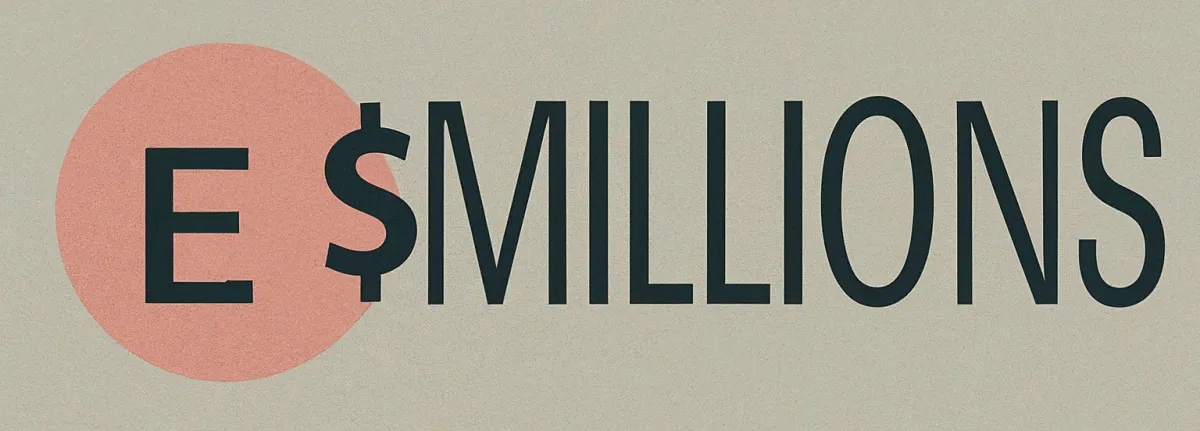
etechmilli@gmail.com
(404) 723-3940
© 2025 Company Name - All Rights Reserved, consectetur adipiscing elit. Maecenas commodo suscipit tortor, vel tristique sapien
